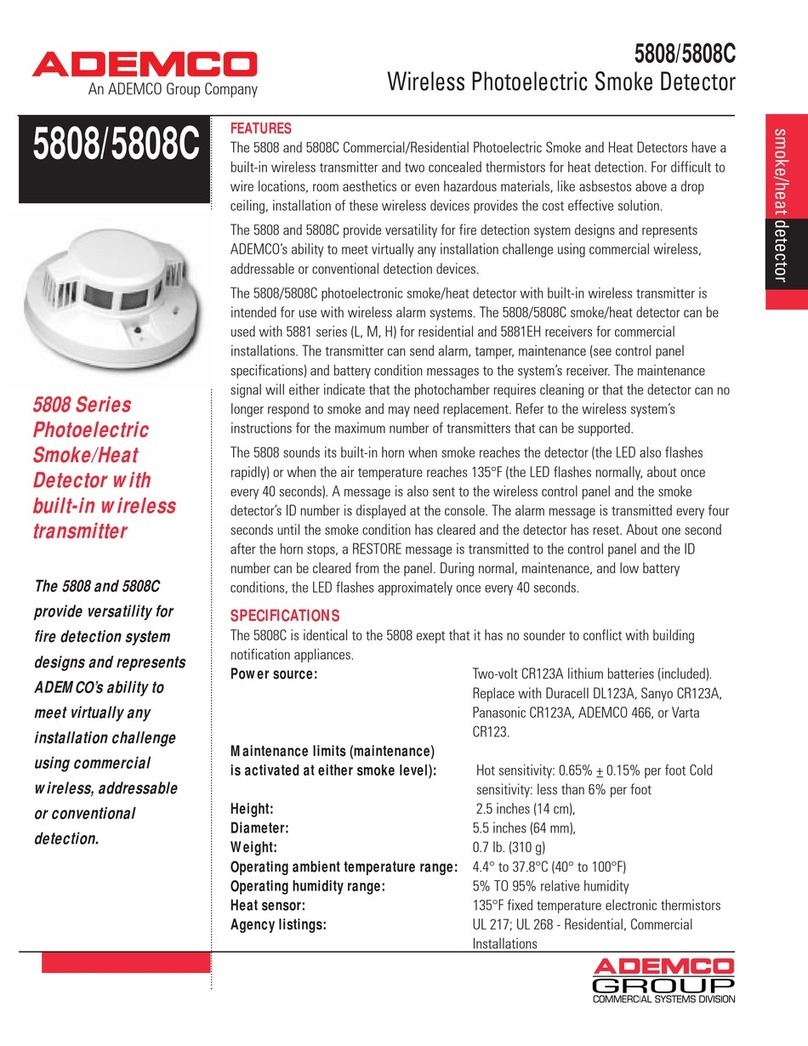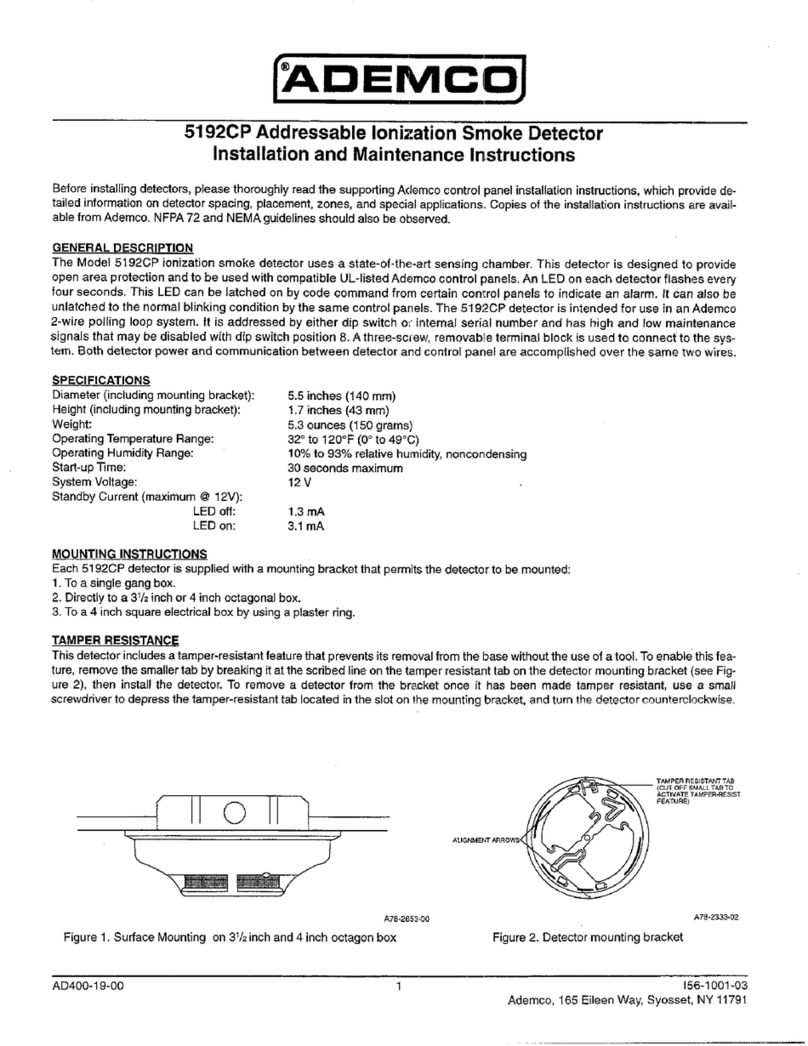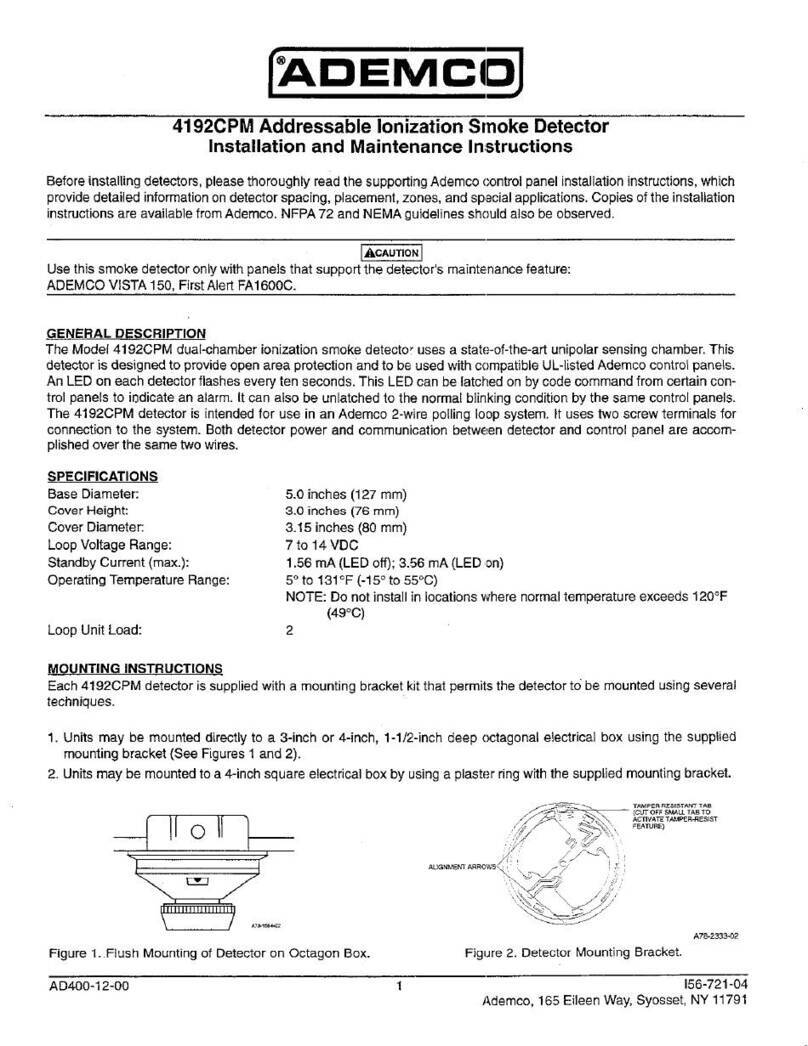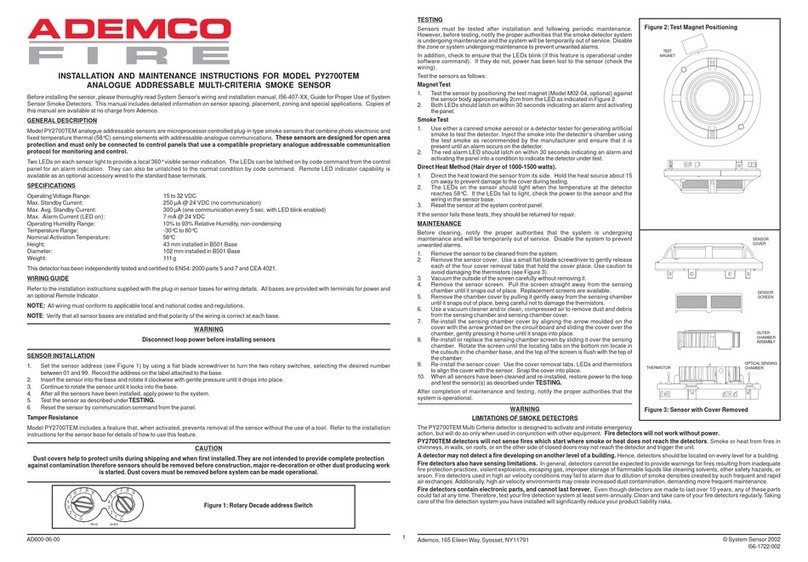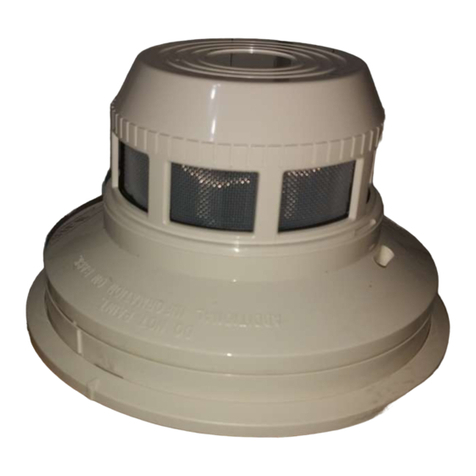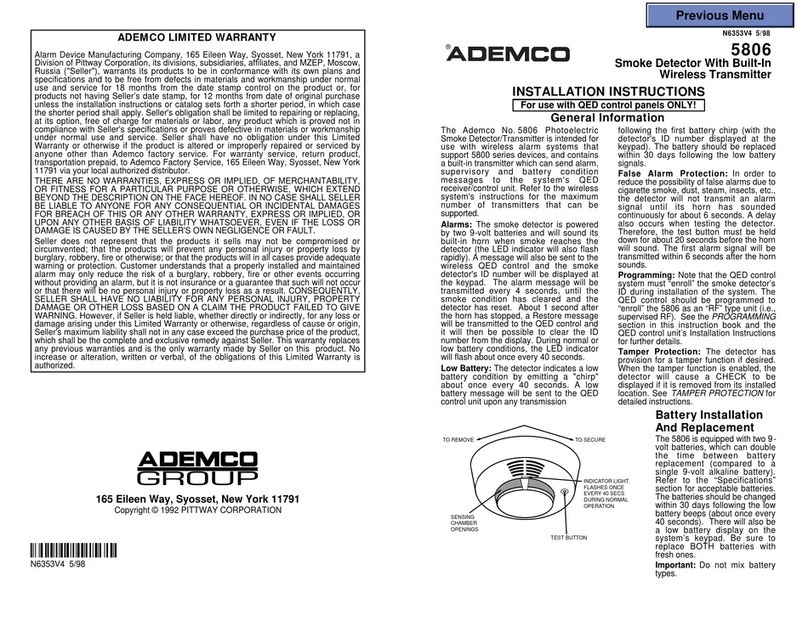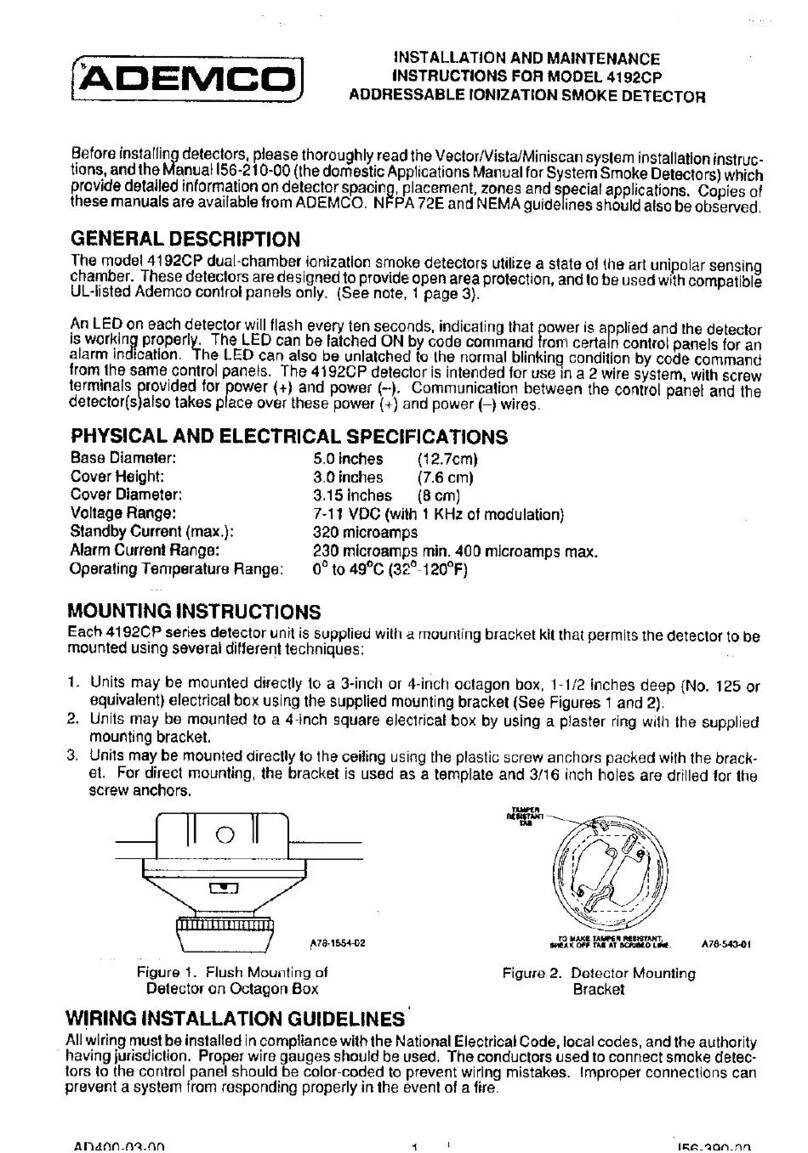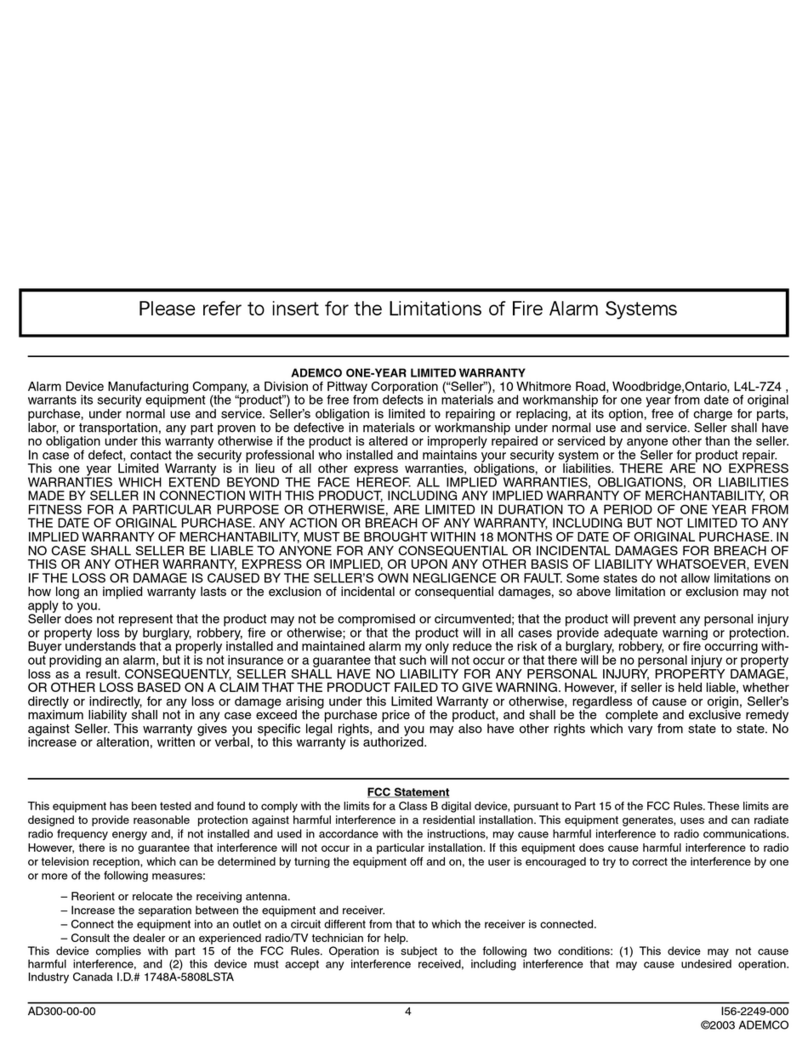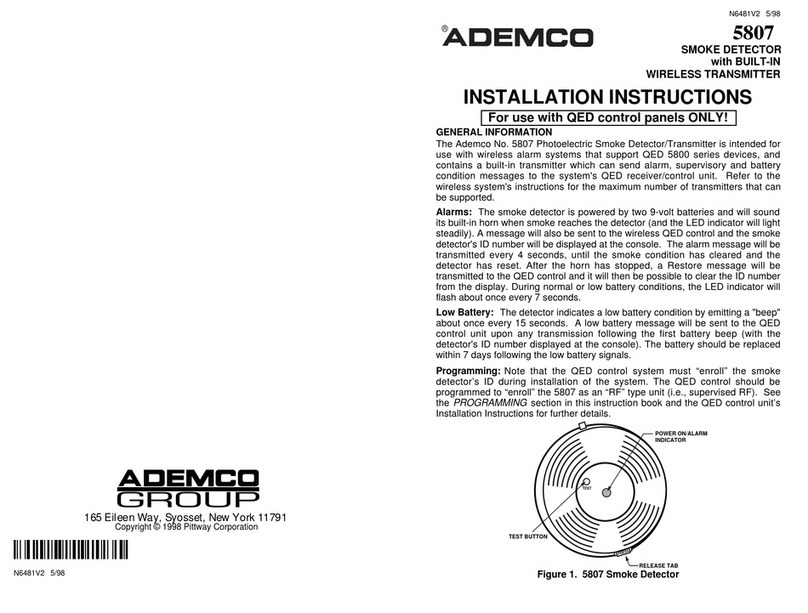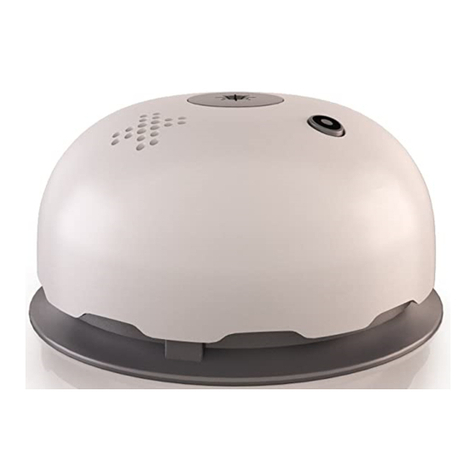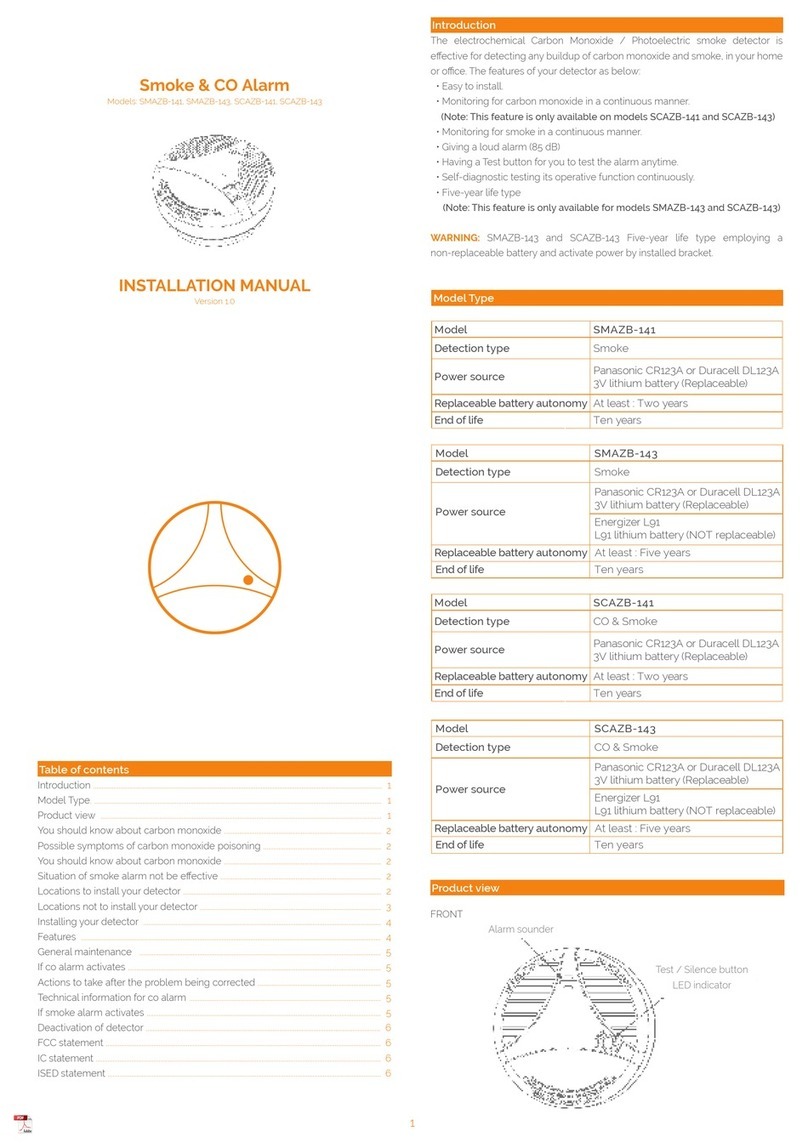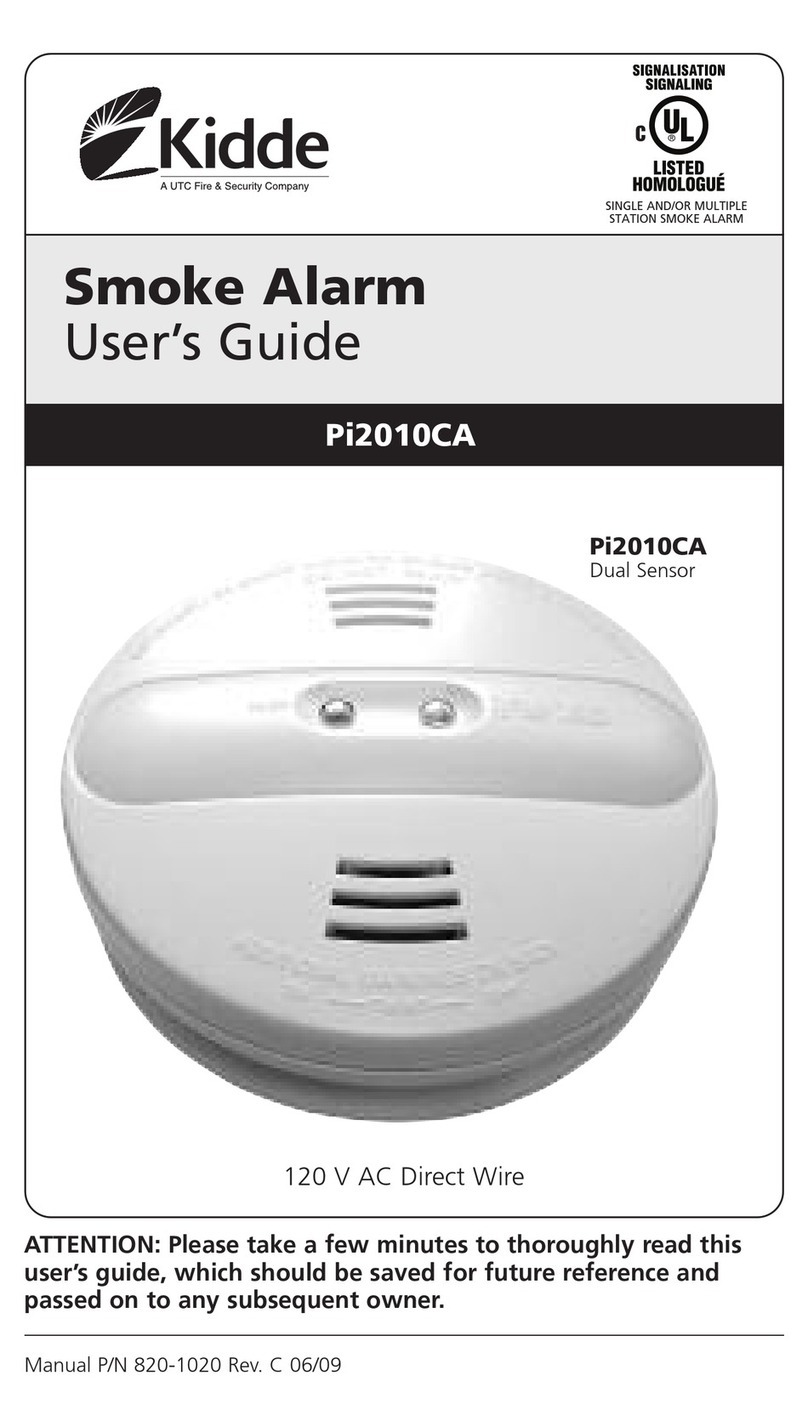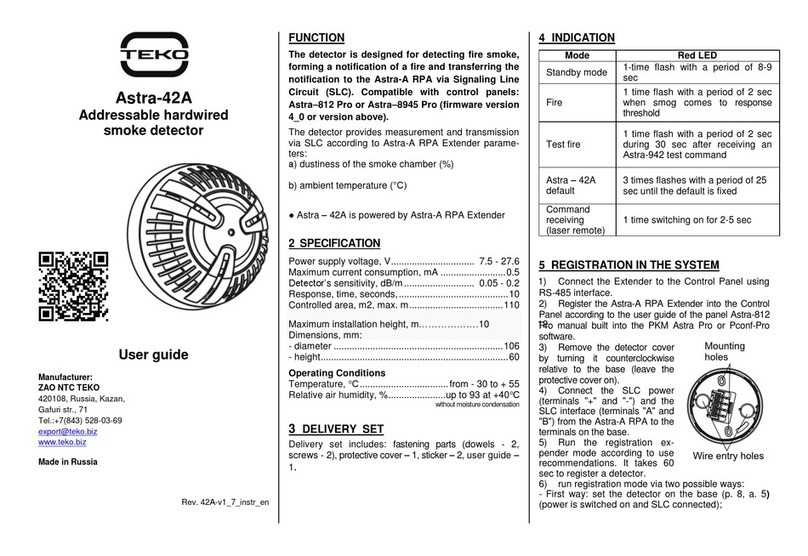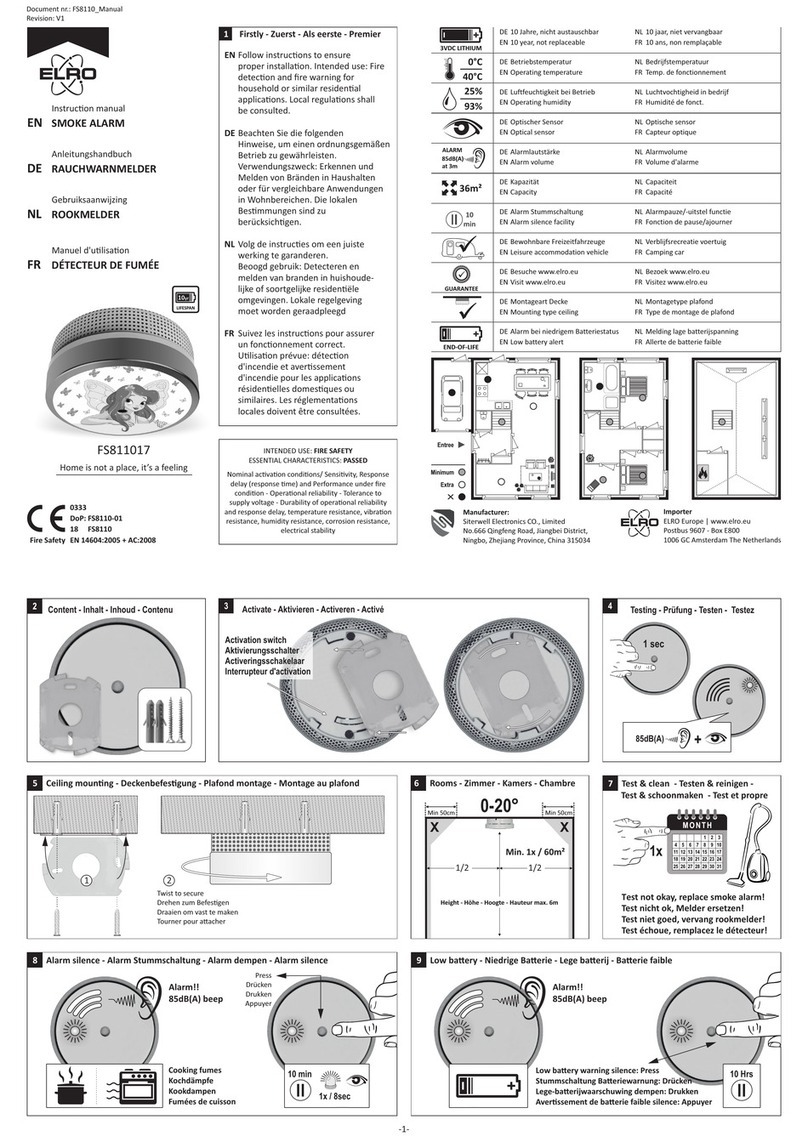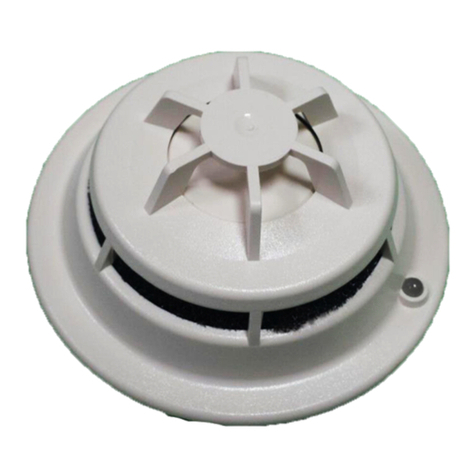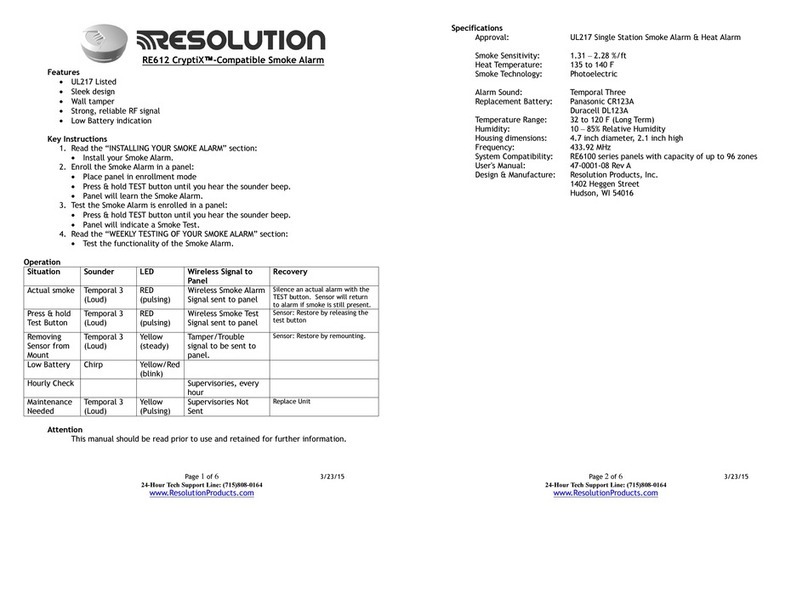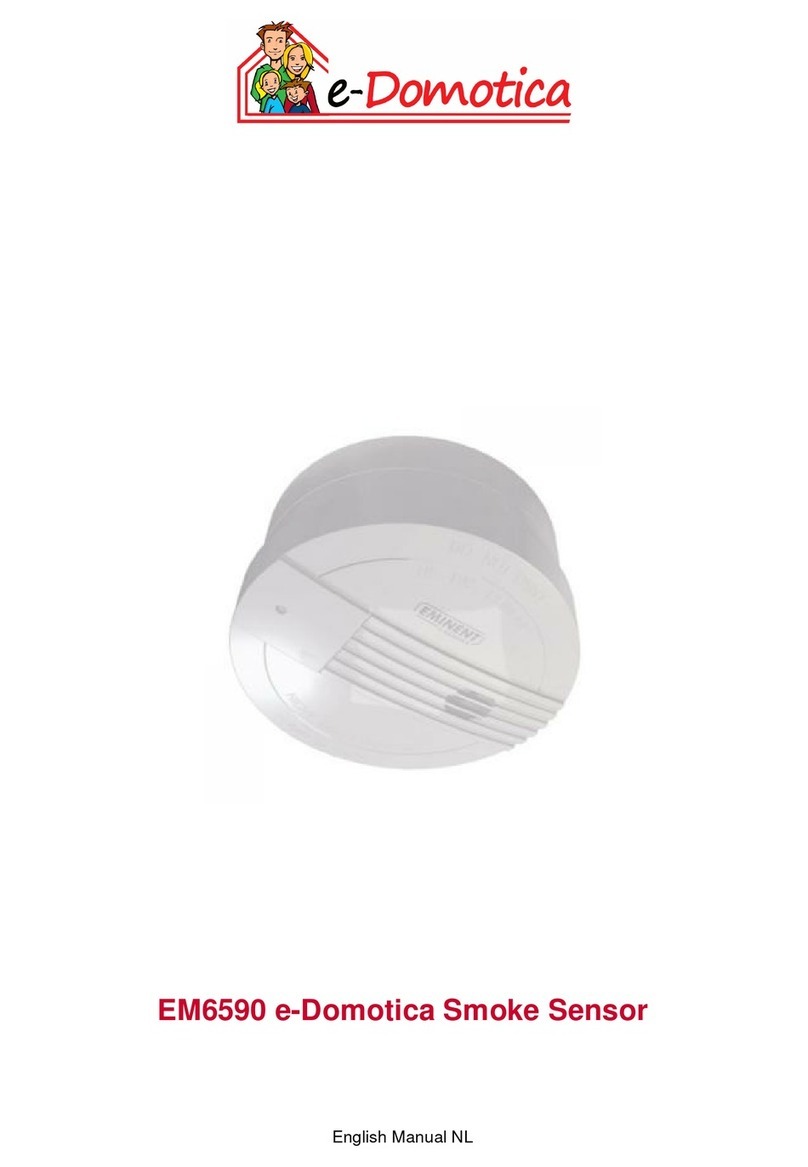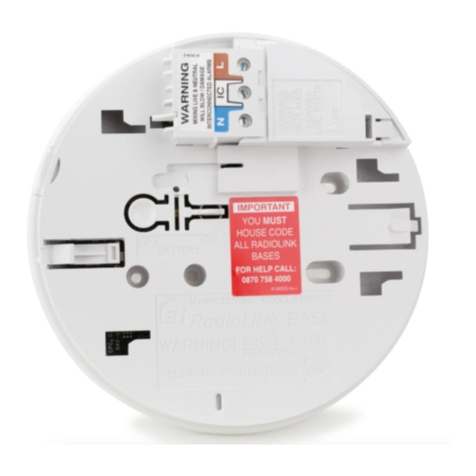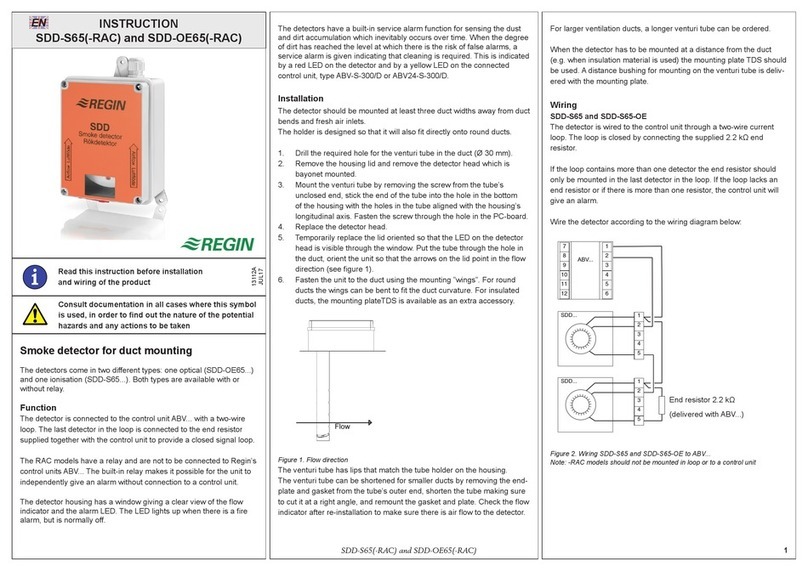
Toreplacebatteries:
1. Removethedetectorfromitsmountingplatebytwistingthedetectorcounter-
clockwise.Removebatteries,ifreplacing,anddispose properly.
2. Installtwonew3-voltCR123ALithiumbatteriesinthebatterycompart-
ment. Followthepolaritydiagraminsidethecompartment.
3. Reinstall the smoke detector onto the mounting plate by turning the
detector clockwise.
4. Test the detector as described in the TESTING TRANSMITTER SIG-
NAL section of this manual. The LED should flash about once every 40
seconds to indicate normal operation. If the batteries are not installed
correctly, the smoke detector will not operate and the batteries may be
damaged.Ifthedetectordoesnotappeartobesendingasignalduring
anyofthetests,checkforcorrectbatteryinstallation.
Test Module
Port
Indicator Light
Pulsing: Normal/Thermal Alarm
Fast Blink: Smoke Alarm
None: Call for Service
Test Switch
Figure1. 5808Wireless Smoke/ Heat Detector
PROGRAMMING
Thesmokedetector’sIDmustbeenrolledintheQEDcontrolpanelduring
installationofthesystem.TheQEDcontrolpanelshouldbeprogrammed
toenrollthe 5808asan“RF”unit(mustbeprogrammedas“supervisedRF”
for UL installations). Put the QED control panel in the program
mingmodeand performthefollowing:
With the QED control panel, program the detector as loop 1 and either
manuallyentertheserialnumberthatisonthelabelofthe 5808,orpress
thetestswitchtocauseatransmission. Additionaltransmissionswillcause
the“Confirm”display toappearonthekeypad display.
SeetheQEDcontrolunit’sinstallationinstructionsforfurtherdetails.
Beforeinstallingdetectors,pleasethoroughlyreadtheseinstallationinstruc-
tionsandManualI56-407,
GuideforProperUseofSystemSmokeDetectors,
whichprovidesdetailedinformationondetectorspacing,placement,zoning,
wiring, and special applications. Copies of this manual are available from
ADEMCO.
NOTICE:Thismanualshouldbeleftwiththeowner/userofthisequipment.
IMPORTANT:Thisdetectormustbetestedandmaintainedregularlyfollowing
NFPA72requirements.Thedetectorshouldbecleanedatleastonceayear.
WARNING: Do not use the maintenance signal as an indication that the
detectorhasreachedthelimitsofitsnominalsensitivityrange.Maintenance
onlyindicatesthatthedetectormayneedcleaningorcannolongerrespond
to smoke and shall not be used as a sensitivity indicating means.
GENERAL DESCRIPTION
The5808photoelectronicsmoke/heatdetectorwithbuilt-inwirelesstransmit-
ter is intended for use with wireless alarm systems that support QED 5800
seriesdevices.RefertoQEDcontrolcommunicatorinstallationinstructions
forcompatibility.The 5808smoke/heatdetectorcanbeusedwith5881series
(L,M,H)and5881EHreceiversforresidentialinstallations.The 5808smoke/
heatdetectorcanbeusedwiththe5881EHreceiverforcommercialinstalla-
tions. The transmitter can send alarm, tamper, maintenance (when QED
control panels are equipped to process maintenance signals), and battery
conditionmessagestotheQEDsystem'sreceiver. Themaintenancesignal
willeitherindicatethatthephotochamberrequirescleaningorthatthedetector
can no longer respond to smoke and may need replacement. Refer to the
wirelesssystem'sinstructionsforthemaximumnumberoftransmittersthatcan
besupported.
The 5808soundsitsbuilt-in hornwhensmokereachesthedetector(the
LEDalsoflashesrapidly)orwhentheairtemperaturereaches135°F(the
LEDflashesnormally,aboutonceevery40seconds).Amessageisalso
senttothewirelessQEDcontrolpanelandthesmokedetector'sIDnumber
is displayed at the console. The alarm message is transmitted every 4
secondsuntilthesmokeconditionhasclearedandthedetectorhasreset.
About1secondafterthehornstops,aRESTOREmessageistransmitted
totheQEDcontrolpanelandtheIDnumbercanbeclearedfromthepanel.
Duringnormal,maintenance,andlowbatteryconditions,theLEDflashes
approximatelyonceevery40seconds.
BATTERY INSTALLATION AND REPLACEMENT
The5808ispoweredbytwo3-voltCR123AorDL123ALithiumbatteries
(included).ThedetectorchecksforlowbatteriesateverynormalLEDflash.
Ifalowbatteryisdetected,thetransmittersendsalowbatterymessageto
theQED control panel,whichbeeps and displaysthedetector's ID. This
conditionwillexistfor a minimum of seven days, and then the detector's
hornwill"chirp"aboutevery40seconds.Thebatteriesshouldbereplaced
BEFOREthechirpsbegin.BESURETOREPLACEBOTHBATTERIES
WITH FRESH ONES.
AD300-00-00 I56-918-06
ADEMCO, 165 Eileen Way, Syosset, New York 11791
AD300-00-00 4 I56-918-06
© ADEMCO 1998
WARNING
LIMITATIONS OF SMOKE DETECTORS/TRANSMITTERS
This smoke detector is designed to activate and initiateactivate and initiate
activate and initiateactivate and initiate
activate and initiate emergency
action, but will do so only when used in conjunction with an authorized
fire alarm system. This detector must be installed in accordance with
NFPA standard 72..
..
.
Smoke detectors will not work without power.Smoke detectors will not work without power.
Smoke detectors will not work without power.Smoke detectors will not work without power.
Smoke detectors will not work without power. AC or DC powered
smokedetectorswillnotworkifthepowersupplyiscutoffforanyreason.
Alarm signal sent by the wireless transmitter in this detector may be
blocked or reflected by metal before reaching the alarm receiver. Even
if the signal path has been recently checked, blockage can occur if a
metal object is moved into the path.
Smokedetectorswillnotsensefires whichstartwheresmokedoesSmokedetectorswillnotsensefires whichstartwheresmokedoes
Smokedetectorswillnotsensefires whichstartwheresmokedoesSmokedetectorswillnotsensefires whichstartwheresmokedoes
Smokedetectorswillnotsensefires whichstartwheresmokedoes
notreachthedetectors.notreachthedetectors.
notreachthedetectors.notreachthedetectors.
notreachthedetectors. Smolderingfirestypicallydonotgeneratealot
ofheatwhichisneededtodrivesmokeuptotheceilingwherethesmoke
detectoris usually located.Forthis reason, theremay be largedelaysin
detecting a smoldering fire with either an ionization-type detector or a
photoelectric-type detector. Either one of them may alarm only after
flaming has initiated, which will generate the heat needed to drive the
smoke to the ceiling.
Smoke from fires in chimneys, in walls, on roofs, or on the other side of
aclosed doormaynot reachthe smoke detectorand alarm it.A detector
cannot quickly detect, or sense at all, a fire developing on another level
ofabuilding.Alarmwarningdevices,such asbellor horns,maynotalert
peopleorwakeupsleepersiftheyarelocatedontheothersideofclosed
or partly open doors, or on another level. Persons may not hear a
warning device over the noise levels of a radio, air conditioner or other
appliances, or traffic. For this reason, detectors shall be located ondetectors shall be located on
detectors shall be located ondetectors shall be located on
detectors shall be located on
every level and in every bedroom within a building.every level and in every bedroom within a building.
every level and in every bedroom within a building.every level and in every bedroom within a building.
every level and in every bedroom within a building. Alarm warning
devices,howeverloud,maynotwarnhearing-impairedpeopleorwaken
deep sleepers.
Smoke detectors shall be located in any room where an alarmSmoke detectors shall be located in any room where an alarm
Smoke detectors shall be located in any room where an alarmSmoke detectors shall be located in any room where an alarm
Smoke detectors shall be located in any room where an alarm
control is located, or in any room where alarm control connectionscontrol is located, or in any room where alarm control connections
control is located, or in any room where alarm control connectionscontrol is located, or in any room where alarm control connections
control is located, or in any room where alarm control connections
to an AC source or phone lines are made.to an AC source or phone lines are made.
to an AC source or phone lines are made.to an AC source or phone lines are made.
to an AC source or phone lines are made. If detectors are not so
located, a fire within any of these rooms could prevent the QED control
from reporting a fire.
Smoke detectors have sensing limitations, too.Smoke detectors have sensing limitations, too.
Smoke detectors have sensing limitations, too.Smoke detectors have sensing limitations, too.
Smoke detectors have sensing limitations, too. Ionization detectors
and photoelectronic detectors are required to pass fire tests of the
flaming and smoldering types. This is to ensure that both can detect a
wide range of fires. Ionization detectors offer a broad range of fire-
sensing capability, but they are somewhat better at detecting fast-
flamingfiresthanslow-smolderingfires.Photoelectronicdetectorssense
smolderingfires better than flaming fires,which have little, if any,visible
smoke.Becausefiresdevelopindifferentways,andareoftenunpredict-
able in their growth, neither type of detector is always best, and a given
detector may not always provide early warning of a specific type of fire.
A78-2332-01
5808 Photoelectronic Smoke/Heat Detector with5808 Photoelectronic Smoke/Heat Detector with
5808 Photoelectronic Smoke/Heat Detector with5808 Photoelectronic Smoke/Heat Detector with
5808 Photoelectronic Smoke/Heat Detector with
Built-inBuilt-in
Built-inBuilt-in
Built-inWirelessWireless
WirelessWireless
WirelessTT
TT
Transmitter Installation Instructionsransmitter Installation Instructions
ransmitter Installation Instructionsransmitter Installation Instructions
ransmitter Installation Instructions
SPECIFICATIONSSPECIFICATIONS
SPECIFICATIONSSPECIFICATIONS
SPECIFICATIONS
Power Source: Two 3-volt CR123A Lithium Batteries (included). (Replace with Duracell DL123A, Sanyo
CR123A, Panasonic CR123A, ADEMCO 466, or Varta CR123A.)
Maintenance Limits (Maintenance signal
is activated at either smoke level): Hot Sensitivity: 0.65% ± 0.15% per foot
Cold Sensitivity: less than 6% per foot
Height: 2.5 inches (14 cm)
Diameter: 5.5 inches (64 mm)
Weight: 0.7 lb. (310 g)
Operating Ambient Temperature Range: 4.4° to 37.8° C (40° to 100° F)
Operating Humidity Range: 5% to 95% Relative Humidity
Heat Sensor: 135° F Fixed Temperature Electronic Thermistors
Agency Listings: UL 217; UL 268 – Residential, Commercial Installations
ADEMCO ONE-YEAR LIMITED WARRANTYADEMCO ONE-YEAR LIMITED WARRANTY
ADEMCO ONE-YEAR LIMITED WARRANTYADEMCO ONE-YEAR LIMITED WARRANTY
ADEMCO ONE-YEAR LIMITED WARRANTY
AlarmDevice Manufacturing Company,aDivision of PittwayCorporation
(“Seller”), 165 Eileen Way, Syosset, NY 11791, warrants its security
equipment (the “product”) to be free from defects in materials and
workmanship for one year from date of original purchase, under normal
use and service. Seller’s obligation is limited to repairing or replacing, at
itsoption,freeofchargeforparts,labor,ortransportation,anypartproven
tobedefectiveinmaterialsorworkmanshipundernormaluseandservice.
Sellershallhavenoobligationunderthiswarrantyotherwiseiftheproduct
is altered or improperly repaired or serviced by anyone other than the
seller. In case of defect, contact the security professional who installed
and maintains your security system or the Seller for product repair.
This one year Limited Warranty is in lieu of all other express warranties,
obligations, or liabilities. THERE ARE NO EXPRESS WARRANTIES
WHICH EXTEND BEYOND THE FACE HEREOF. ALL IMPLIED WAR-
RANTIES, OBLIGATIONS, OR LIABILITIES MADE BY SELLER IN
CONNECTION WITH THIS PRODUCT, INCLUDING ANY IMPLIED
WARRANTYOFMERCHANTABILITY,ORFITNESSFORAPARTICU-
LAR PURPOSE OR OTHERWISE, ARE LIMITED IN DURATION TO A
PERIODOF ONEYEAR FROMTHEDATE OFORIGINAL PURCHASE.
ANY ACTION OR BREACH OF ANY WARRANTY, INCLUDING BUT
NOTLIMITEDTOANYIMPLIEDWARRANTYOFMERCHANTABILITY,
MUST BE BROUGHT WITHIN 18 MONTHS OF DATE OF ORIGINAL
PURCHASE. IN NO CASE SHALL SELLER BE LIABLE TO ANYONE
FOR ANY CONSEQUENTIAL OR INCIDENTAL DAMAGES FOR
BREACH OF THIS OR ANY OTHER WARRANTY, EXPRESS OR
IMPLIED, OR UPON ANY OTHER BASIS OF LIABILITY WHATSO-
EVER,EVENIFTHELOSSORDAMAGEISCAUSEDBYTHESELLER’S
OWNNEGLIGENCE ORFAULT. Somestates donotallowlimitationson
how long an implied warranty lasts or the exclusion of incidental or
consequential damages, so above limitation or exclusion may not apply
to you.
Seller does not represent that the product may not be compromised or
circumvented;thattheproductwillpreventanypersonalinjuryorproperty
loss by burglary, robbery, fire or otherwise; or that the product will in all
cases provide adequate warning or protection. Buyer understands that a
properly installed and maintained alarm my only reduce the risk of a
burglary,robbery, or fire occurring without providing analarm,but it is not
insurance or a guarantee that such will not occur or that there will be no
personal injury or property loss as a result. CONSEQUENTLY, SELLER
SHALL HAVE NO LIABILITY FOR ANY PERSONAL INJURY, PROP-
ERTY DAMAGE, OR OTHER LOSS BASED ON A CLAIM THAT THE
PRODUCTFAILEDTOGIVEWARNING.However,ifsellerisheldliable,
whether directly or indirectly, for any loss or damage arising under this
Limited Warranty or otherwise, regardless of cause or origin, Seller’s
maximum liability shall not in any case exceed the purchase price of the
product, and shall be the complete and exclusive remedy against Seller.
Thiswarrantygivesyouspecificlegalrights, andyoumay alsohaveother
rights which vary from state to state. No increase or alteration, written or
verbal, to this warranty is authorized.
In general, detectors cannot be expected to provide warnings for fires
resulting from inadequate fire protection practices, violent explosions,
escaping gases that ignite, improper storage of flammable liquids like
cleaningsolventsthatignite,othersimilarsafetyhazards,arson,smoking
in bed, children playing with matches or lighters, etc. Smoke detectors
used in high air velocity conditions may have a delay in alarm due to
dilution of smoke densities created by frequent and rapid air exchanges.
Additionally, high air velocity environments may create increased dust
contamination, demanding more frequent detector maintenance.
To keep your equipment in excellent working order, ongoing mainte-
nanceis required per the manufacturer’srecommendations and UL and
NFPAstandards. Ata minimum,the requirementsof Chapter7 ofNFPA
72, the National Fire Alarm Code, shall be followed. A preventative
maintenance agreement should be arranged through the local
manufacturer’s representative. Though smoke detectors are designed
for long life, they may fail at any time. Any smoke detector, fire alarm
equipment,oranycomponentofthatsystemwhichfailsshallberepaired
or replaced as soon as possible.
NOTE: Before removing the detector, notify the proper authorities
that the smoke detector system is undergoing maintenance
and will be out of service. Disable the zone or system under-
going maintenance to prevent unwanted alarms.
1. Remove the detector cover by placing a small-bladed screwdriver in
the cover removal slot and twisting it slightly until the cover can be
turned counterclockwise for removal.
2. Removethescreenbypullingitstraightout(seeFigure8).Vacuumthe
screenthoroughly.
3. Clean the black vaned chamber piece by vacuuming or blowing out
dust and particles.
4. Toreinstall thescreen,rotate thescreen on thehousing until itdrops
into the alignment slots. Carefully push the screen onto the base,
making sure it fits tightly to the chamber. Replacement screens are
available (order part number RS23).
5. Replace the cover by rotating it clockwise until it locks in place.
6. Reinstallthedetectorintothesystem, enable system operation, and
notify the proper authorities that the system is back on line.
For use with QED control panel ONLY!
R


